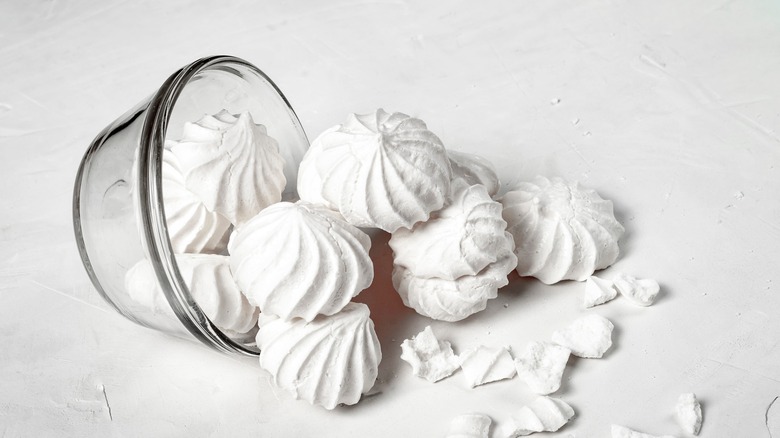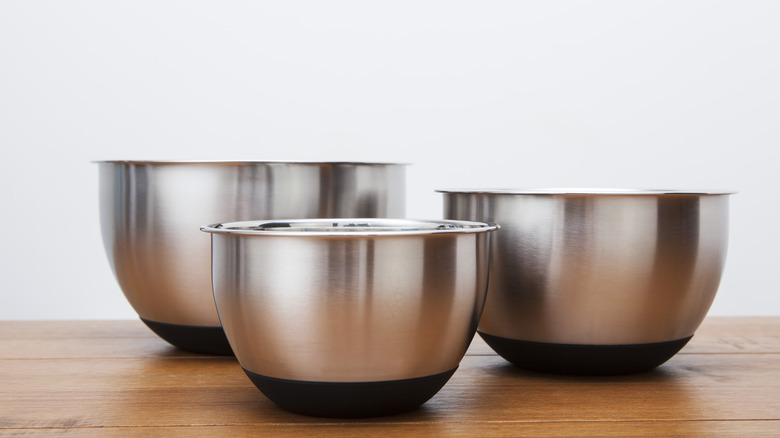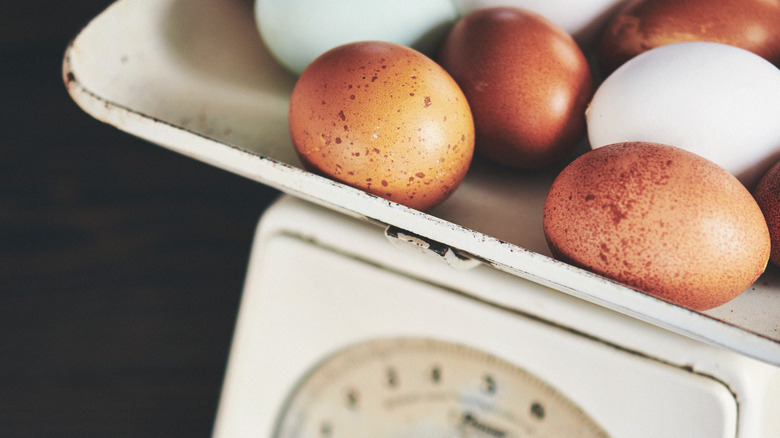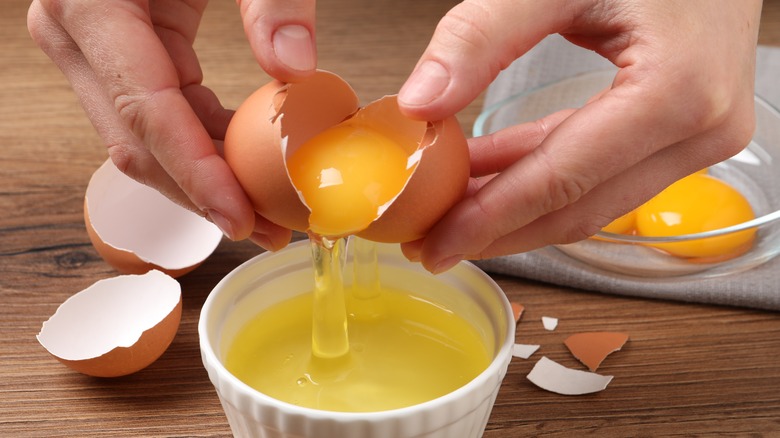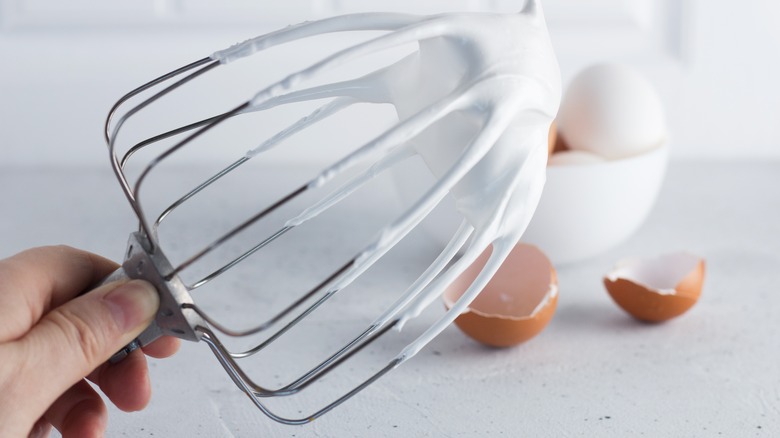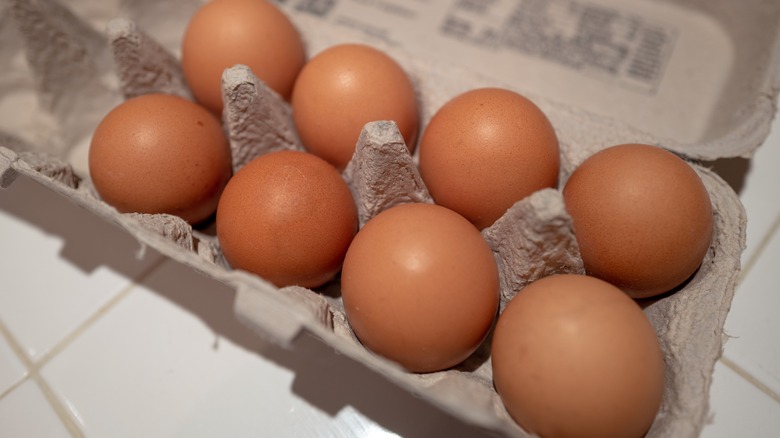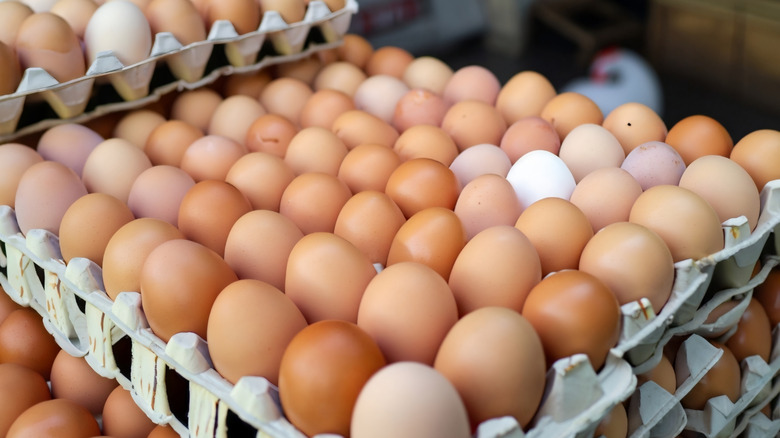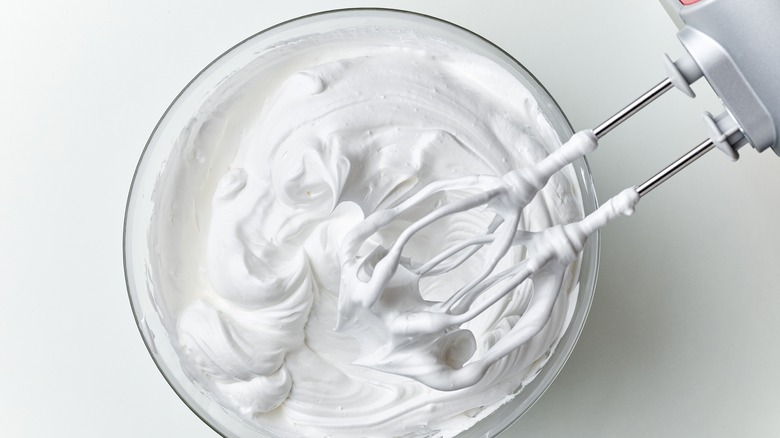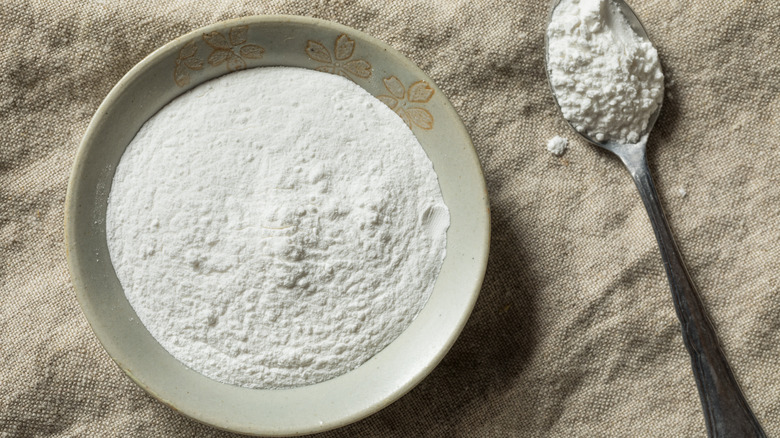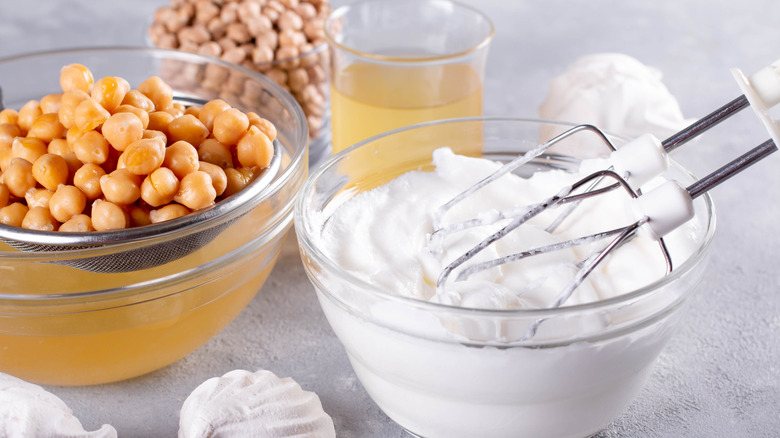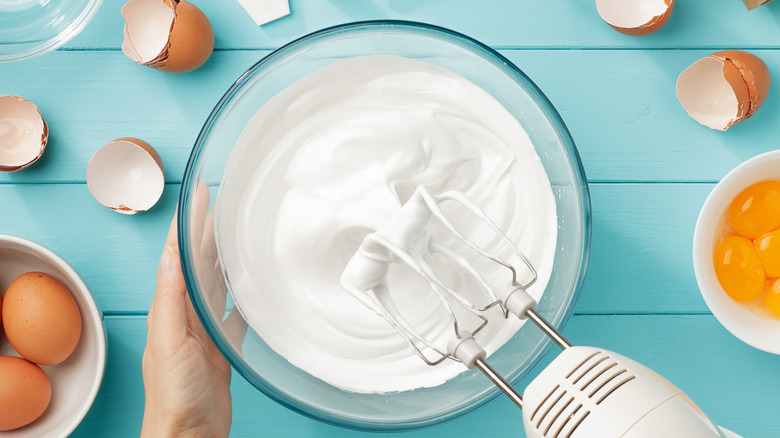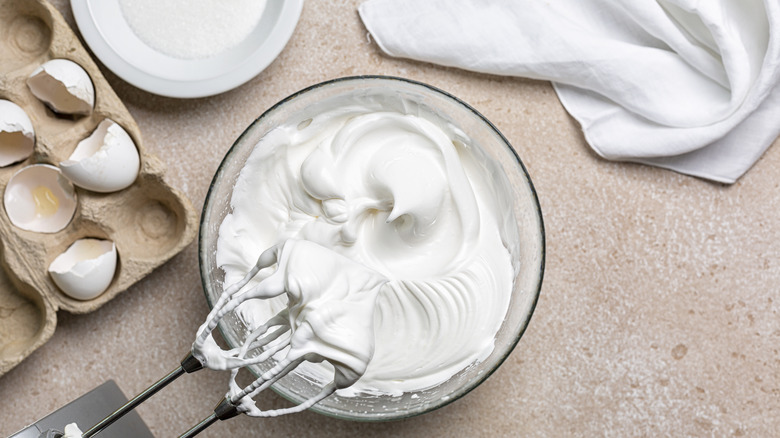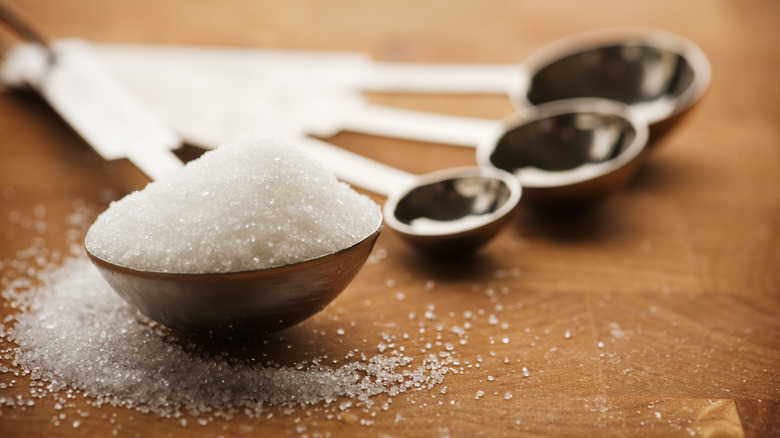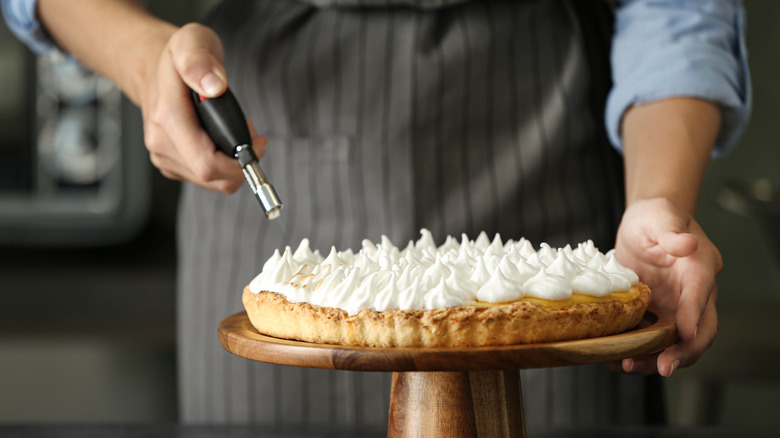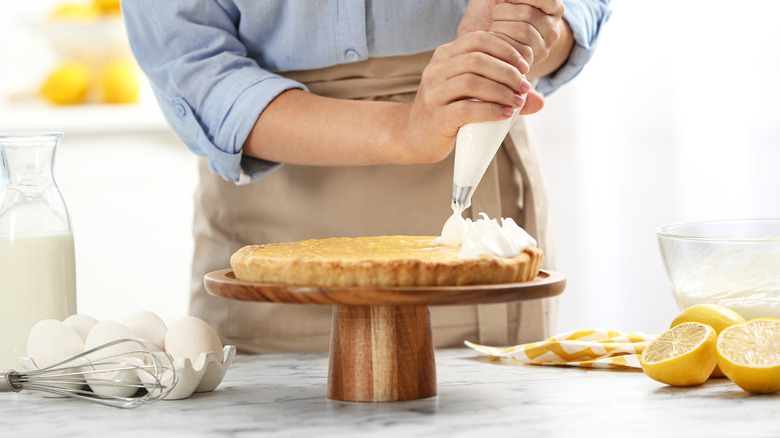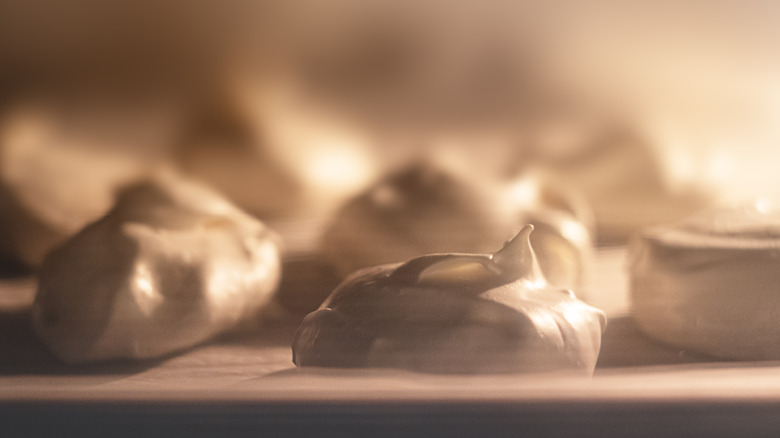15 Costly Mistakes You're Making With Meringue
Meringues are a bit of an enigma in the world of sweets. They're not quite as soft and squishy as a marshmallow, but they also don't have the firm, crumb texture of a traditional cookie or sweet. Despite their odd texture, though, meringue is considered an integral part of the modern baking lexicon. It's the base of desserts like the pavlova, which layers large meringue discs with curd or whipped topping. It can also be found piped on top of pies or baked solo on a cookie sheet. Mastering a meringue is also important for baking a batch of French macarons or mixing it into certain types of frostings.
Although the recipe for meringues — which is as straightforward as mixing whipped egg whites with sugar — might seem easy, there are major mistakes that can come up along the way. They can render your pavlova flat or make your meringue cookies the sham of the cookie swap. Here are some of our most essential tips for making meringues at home and troubleshooting any tricky bends that will come up along the way.
Using a dirty bowl
Meringues only require two ingredients: sugar and egg whites. Notice what we didn't include? Grease. Although we doubt anyone would sabotage their recipe by dumping in oil or butter, you might find that there is a hidden way grease makes its way into your meringues.
Using a dirty bowl is the meringue mistake you weren't aware you were making. If even a minuscule amount of oil from a rinsed-but-not-washed bowl gets into your meringues, it won't foam properly. Plastic tends to develop a residual oil coating and is more difficult to clean, too, so instead, try using a glass, stainless steel, or metal bowl. Another way to ensure your bowl is correctly prepped for making meringues is to swipe the inside of it with distilled white vinegar. For perfect meringue, you can also rub the bowl with half a lemon. For safety's sake, you should also take care to ensure your whisk and attachments are also free of any residue.
Improperly measuring eggs
One of the cornerstones of proper baking is ensuring that your recipe contains all the proper measurements. If you neglect to measure your egg whites properly, you may end up with a pavlova that is too small or a batch of meringue cookies that is too bite-sized.
A large egg typically contains about 1.19 ounces of egg whites. However, egg cartons graded as "large" must weigh a total of 24 ounces. This means that some eggs may be slightly larger than the others. In comparison, extra-large eggs must weigh a total of 27 ounces, while medium eggs are only 21 ounces. For most people, these are just numbers being thrown around, but they can compound into bigger problems later on in the baking process if you fail to take them into account. If you're making a meringue recipe at home, measuring the egg whites after you've cracked them into a separate bowl is best. You can also purchase the egg grade as it's written in the recipe rather than choosing whatever egg grade is on sale at the grocery store.
Contaminating it with yolks
One of the biggest mistakes people make with meringues comes before any mixing implements are even involved. When you're cracking your eggs, you must be very careful not to get any yolk involved.
Failing to separate the yolks and the whites properly is the biggest mistake you're making with meringue. Fatty egg yolks will prevent the formation of egg whites, which can lead to a poor whip. You'll know there's something wrong if your meringue comes out runny without any valleys or peaks. Even a few drops of yolk can destroy your recipe, so you'll want to be careful to avoid any messiness when separating the eggs.
The best way to ensure that no eggs get into your meringue bowl is to crack them separately and pour the egg whites into the main mixing bowl from there. While an egg separator tool will take a lot of time, it will be the best bet for separating your eggs without the risk of dropping the yolks.
Making the wrong type of meringue
There are several different types of meringue to choose from. For example, Italian meringue is unique because it mixes egg whites with hot sugar syrup. This process cooks the egg whites and produces a meringue that' is more structurally sound than other varieties, so it's perfect for French macarons. In comparison, French meringue is made by just beating together egg whites and sugar — meaning that it's not safe to eat unbaked. However, the French style is by far the most straightforward meringue technique to make at home, so it's the best recipe to make if you're a meringue novice. Swiss meringue is one of the most challenging types of meringue to make because it involves cooking egg whites and sugar over a double boiler. Your choice in meringues will involve what type of recipe you're making and how comfortable you feel making the iconic topping.
Neglecting to bring your eggs to room temperature
While cold eggs may be easier to separate the yolk from the white, it's not the ideal formula for mixing and preparing your meringue. Room-temperature egg whites tend to whip up better and faster, which results in a lighter and fluffier meringue.
The ideal temperature for whipping egg whites is around 70 F. The quickest method for getting eggs to room temperature is to place the eggs in a bowl of warm water for about five to ten minutes. You'll know that the eggs are ready to crack when they feel about the same temperature as the surrounding water. If you are insistent on using cold eggs, you can whip them at a lower speed for a minute or two until they start to warm up and loosen. Then, you can go full speed ahead and whip your eggs to their fullest potential.
Using old eggs
There is a careful balance of adding egg whites to your meringue. Not only does size matter, but also the age of the egg. Old egg whites tend to be thinner, which allows for an easier whip. However, the thin egg whites often mean that the mixture is more watery and weepy than if you used a fresh egg. This is because when the egg ages, it becomes more alkaline (less acidic), which causes the proteins in the whites to repel one another.
Using older egg whites means that you will have to sacrifice the stability, thus risking deflation. If you want to use an older egg for adding air to an angel food cake or a souffle, then so be it. You can test the age of your egg by submerging it in a glass of water. If the egg floats, it is too old to use for your meringues. Alternatively, if your egg sits comfortably on the bottom of your glass, you're good to go.
Not watching the weather before making meringue
The weather is an integral part of our lives, but it's especially important if you try making meringues at home. The worst weather for making meringues, according to Ina Garten, is when it's humid and damp outside.
Egg whites are made of about 90% water and 10% protein. When you whip egg whites at high speeds, the air causes some of the proteins to denature, which causes the amino acid building blocks to separate from the water and attach to the air instead. When any sort of moisture in the air is present, it alters the denaturing process and won't produce the same quality white. You'll know it's too humid when the meringue isn't crunchy — it's soft, chewy, and plain unappetizing.
There's no way to avoid or counteract this phenomenon. No number of dehumidifiers will help your meringues rise to the occasion, so you're best off saving the recipe for a dry day instead.
Omitting a stabilizing agent
Egg whites and sugar are the only two ingredients you actually need for meringue — but adding some extra ingredients can help ensure it comes out perfect every time. Cream of tartar is the ingredient you need for a stable meringue because it causes a chemical reaction with the egg whites. It strengthens the bond between the trifecta of water, proteins, and air. Meringues that include cream of tartar tend to weep less when you pipe them onto a pie.
Besides cream of tartar, you can use confectioner's sugar in your recipe. This ingredient is not the same as powdered sugar because it contains cornstarch. This starchy staple will help stabilize your meringue; it only comprises about 3% to 5% of the sugar's weight, making it a very minuscule part of the formula. However, the result will be a sturdier meringue cookie that's easier to pipe and won't weep as much.
Not trying an egg-free meringue
Vegans don't have to give up on having a meringue. Aquafaba, which is the liquid inside a chickpea can, is a delicious, animal-free substitute for the classic egg whites. Two tablespoons of this bean juice can be substituted for a single egg white in a recipe; you don't need to add sugar for the substitution to work.
When making this recipe, you'll always want to use chickpeas from a can rather than dried beans soaked at home. In addition, chickpeas always produce the most flawless result, making it a much more functional and aesthetic option than black bean or white bean juice. You should also be prepared that it will take up to 15 minutes to reach the perfect whipped texture, while eggs might be done in a matter of five. To help ensure your aquafaba comes out perfect, try adding about an ⅛ teaspoon of cream of tartar for each "egg."
Overbeating your egg whites
If you can beat something in baking, you can, too, overbeat it. Egg whites that have been overbeaten will come out dry, clumped, and lack the perfect shine. Furthermore, there won't be any stiff peaks, and your meringue cookies will be sad.
The simple trick for fixing overbeaten egg whites is introducing more egg whites. Gently pour in an additional egg white and whisk gently with a handheld beater. This will introduce more moisture into the recipe — just be sure not to overbeat the extra egg white in the recipe. Alternatively, you can also add an acid to prevent overbeating your egg whites. The acid will prevent certain parts of the egg from bonding tightly, causing too much foam separation. Cream of tartar is the best ingredient to do this, but adding vinegar or lemon juice to the mix is also a viable yet underperforming addition.
Underbeating your egg whites
The only thing worse than overbeating your egg whites is underbeating them. After all, there is no green light that goes off when it's time to stop beating your eggs.
There are a few milestones you'll need to look for when whipping egg whites. The first is the soft peak stage, which is when soft, curled peaks start to form — kind of like waves on the ocean. Soft peak stage typically occurs after about a minute of whipping with an electric or stand mixer. The stiff peak stage will occur after you add the sugar and the egg whites stand up on the whisk when it's flipped upside-down. Reaching this stage will take about four minutes.
If you're making another recipe requiring egg whites, like a souffle or a soft angel food cake, you may not have to beat the eggs to the stiff peak stage. The best policy is to always read the recipe to determine how much to beat the eggs.
Adding the sugar all at one time
Sugar is a critical component of making meringues, but there are some tricky pitfalls that people can make with the recipe that will throw off the texture of the entire recipe. When you're making meringues, you always have to add the sugar gradually rather than dumping in the entire amount at one time. Pouring in the sugar in one shot will increase the amount of time that it takes to whip the batch up, which will just waste more time in the kitchen.
The jury is still out on how to add sugar to the meringues for optimal results. Some homebakers will swear by adding one tablespoon to the recipe at a time, while others will slowly pour in the sugar as the egg whites are whipping. You can also add the sugar into the recipe in thirds: immediately after mixing, once the whites start to foam, and after the soft peak stage. Some outlets even suggest heating up the sugar before whisking it in to help it dissolve quickly. The bottom line is to do what works best for you, as long as you don't add it all at once.
Not adding sugar to your meringue before toasting
Martha Stewart is a professional entertainer, so it's no surprise she has tips for beautiful, elaborately designed meringue pies with her adoring audience. Her sugar tip to give meringue pies a crunchy finish is to add sanding sugar to the top of the meringue before torching it. Per an Instagram post that the lifestyle media mogul shared with her following, Stewart shared that she always uses sanding sugar for this hack rather than regular granulated sugar. Sanding sugar has a much larger crystal size than plain white sugar, which means it will hold up better to torching.
This is also a tip you can use to get the perfect color on baked meringues. Just add a sprinkle of the sanding sugar before baking it for about an hour. Although the oven won't have the direct heat like a propane torch, it will still help develop a perfect color on your meringue.
Pushing all of the air out of your piping bag
Making meringues is a challenge in itself, but piping the confection is a whole new ball game. These meringues are full of air, so any kind of physical manipulation of the mixture will cause the air to push out and subsequently deflate. When you're piping these treats into a baking sheet, you'll want to leave enough space between the piping bag and the baking sheet.
To pipe your meringues effectively, you'll only want to fill up the bag about ¾ of the way full, so you have plenty of room to twist the bag shut. Use your non-dominant hand to guide the bag to where you need to pipe before squeezing on the bag with even pressure to release the meringue. Lift slowly as you squeeze the bag to create perfect meringue dollops. You can also experiment with different tips and patterns to create elaborate designs or swirl in food coloring for a bright meringue.
Pulling a baked meringue out of the oven too quickly
After you've made and piped the meringues, now comes the difficult task of baking them. Essentially, the "baking" process is more of a drying one — meaning that all you're doing is heating the meringue enough to remove the moisture. However, if you start to notice beads of moisture forming on your meringue as it is cooking, this can mean that the temperature of your oven is not high enough, which means the moisture isn't evaporating quickly. To avoid a soggy meringue, turn up the heat. You'll also know the meringues are sufficiently dried when you can pull them off the baking sheet without any sign of sticking.
You also have to take care of your meringues after baking. After all, if you're making a chocolate pavlova, the last thing you want to do is have them crack. To prevent this, you'll want to bake the meringues, then shut off the oven and crack the door ajar to allow the meringue to cool off gradually.
